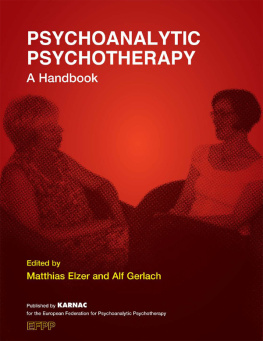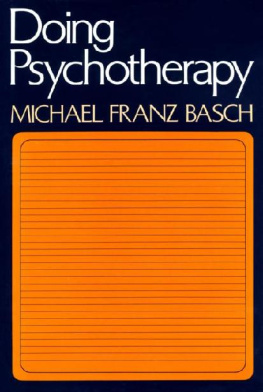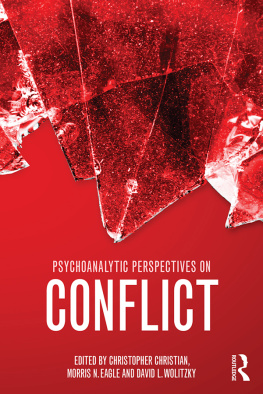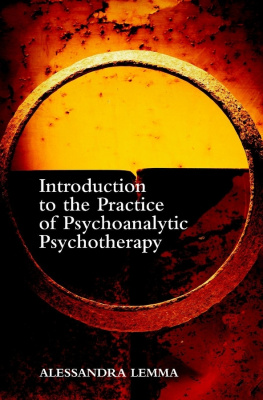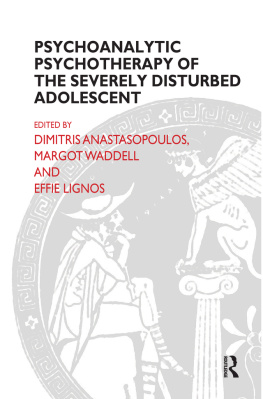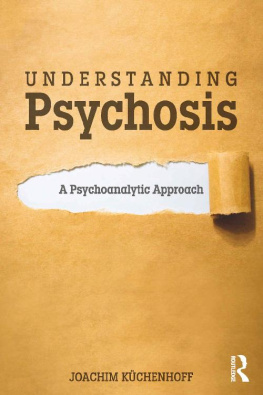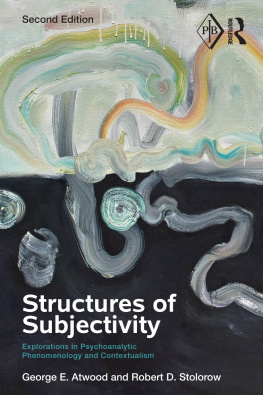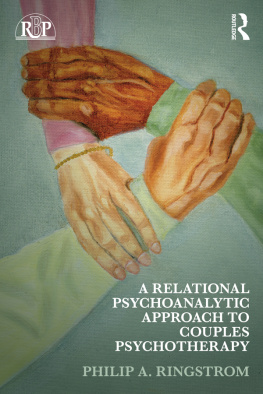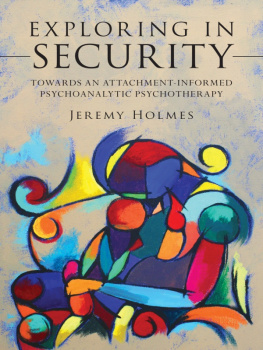The editors want to thank the colleagues who reworked their lectures: Irmgard Dettbarn (Berlin, Beijing), Ulrich Ertel (Frankfurt), Christine Gerstenfeld (Berlin), Stephan Hau (Stockholm), Klaus Kocher (Frankfurt), Wolfgang Merkle (Frankfurt), Hanni Scheid-Gerlach (Saarbrcken), Anne-Marie Schloesser (Gttingen), Joachim Rothhaupt (Darmstadt), Hermann Schultz (Frankfurt, Shanghai), and Michael Wolf (Frankfurt). We also express our thanks to the following organisations, which supported the publication with proof-reading: the German Psychoanalytic Association (DPV); the German Society for Psychoanalysis, Psychotherapy, Psychosomatics and Depth Psychology (DGPT), Breuninger Foundation.
Many thanks also to Gisela Sippel (Germany, Botswana), who read proofs of the English papers of the German lecturers, and to Oliver Rathbone and Rod Tweedy from Karnac for their friendly co-operation.
CHAPTER ONE
PSYCHOANALYTIC THEORY OF THE HUMAN MIND
Hermann Schultz, Joachim Rothhaupt, and Michael Wolf
Psychoanalytic models of the mind
Hermann Schultz
W hat is psychodynamic psychotherapy; what does the term psychodynamic mean? For an answer to this question, let us look at the origins of psychodynamic science, rooted in psychoanalysis and developed by Freud from 1893 onwards. Psychiatric diagnosis in Freud's time was no more than classifying people into different diagnostic categories, for instance, the so-called psychopathic personalities with hysteric, perverse, criminal, or addictive traits, the psychoses (schizophrenia, manicdepressive illness), neurasthenia, etc. Today, our diagnostic systems in psychiatry are much more refined, operationalised, and validated than they were at the turn of the twentieth century: we have ICD-10 or DSM-IV guide us. Nevertheless, the content of these diagnostic systems, too, is restricted to descriptive symptom diagnoses and does not tell us anything about the psychodynamics of the patient's psychic disease. Therefore, for our psychotherapeutic purposes, the symptom diagnosis has to be supplemented by a psychodynamic diagnosis (see Operationalised psychodynamic diagnosis in ).
Psychiatric therapy in Freud's time was mainly somatic treatment, operating on the body through hospitalisation, psychopharmacological medication (e.g., sedatives and stimulantsFreud also experimented with cocaine), electrotherapy, etc. However, for neurotic disorders these somatic therapy forms proved ineffective. Freud found out that in order to help these patients, it was not enough to explore their symptoms, formulate a descriptive symptom diagnosis, and prescribe some somatic treatment. What these patients needed was a therapist who would explore why patients became ill and developed their symptoms at a particular moment or in a specific situation of their life; the reason for their becoming ill (the function and the meaning of their symptoms); in other words, try to understand understand the patient's symptoms as an expression of some inner power struggle between conflicting forces, especially emotional conflicts between specific wishes, needs, and fears of the patient.
Freud discovered that often the deepest longings and fears are unknown to the patient himself (they are unconscious), so you cannot simply ask the patient and get an answer. The therapist must, rather, learn the non-verbal, symbolic, and highly emotional language of the unconscious mind, which is expressed not in words but in the patient's behaviour, his relationships towards other people, his emotional signals, phantasies, and dreams. By understanding not only words but also these non-verbal expressions of the patient's deepest motives and hidden emotions, we can help the patient to better understand himself and others and to master his problems without becoming ill as a result of them.
This approachnot just exploring symptoms as such, but wanting to understand their function and meaning in terms of the underlying emotional forcesis Freud's most important discovery, and this is what he called the psychodynamic point of view. The old Greek word dynamis means power, or force. Of course, here we are dealing not with physical forces, but psychological forces, which we describe in terms of
- drives (e.g., the sexual drive, aggressive impulses of competition or revenge);
- needs (the need for safety, for closeness, for affirmation and self-assertion, for autonomy and independence, the need to feel great sometimes, the need to have someone you can admire and take as a model, etc.);
- emotions (love and hate, anxiety and fear, shame, guilt, envy, jealousy, pride, arrogance, admiration, contempt, etc.).
What Freud and later psychoanalysts discovered is that often
- these manifold dynamic forces are not in harmony but in conflict with each other;
- one important reason for conflict is that some of the deepest needs, emotions, and impulses are rather immature, persisting from childhood and in conflict with adult self-concepts and values; in short, with the adult part of the patient's personality;
- our patients deepest emotional conflicts, which made them become ill, are often unknown to them because these are mostly unconscious;
- such unconscious conflicts are often expressed indirectly, non-verbally, in the patient's symptoms, interpersonal relations, emotional and behavioural signals, which we must understand in order to help the patient in therapy;
- in clinical practice, symptom diagnosis alone is mostly insufficient and has to be supplemented by a psychodynamic diagnosis in terms of emotional conflicts and the way a patient deals with them (defence mechanisms), developmental deficits, personality structure, etc.;
- psychoanalytical psychotherapy aims to help the patient to better understand and accept himself, to realise his emotional conflicts and to develop more adequate solutions for them. Since many of our patients have been hampered in their personality development, resulting in developmental deficits, an additional aim of psychodynamic psychotherapy should be to help them to face reality and resume their personality development in those areas where they are still clinging to childish or juvenile forms of behaviour and experiencein other words, help them to grow up to be a mature adult person.
On the basis of his clinical observations, Freud tried to order his findings systematically and develop a psychological model of mental functioning. Since the neuro-scientific knowledge of the brain and its functions was still very limited in his time, Freud had to give up his first attempt, in 1895, at constructing a neuropsychological model of mental functioning in health and mental disease. So, from that time on, he tried to outline a psychological theory of mental functioning. I want to be brief and concentrate upon the essentials.
In the development of psychoanalysis, we may distinguish first Freud's three models of the mind. After Freud's death in 1939, the development did not stop, but as the clinical spectrum changed, psychotherapists were confronted with new kinds of patients (for instance, patients with narcissistic and borderline personality disorder), necessitating new psychodynamic models to understand and treat them. From our clinical practice today, we see that the earlier models were not completely wrong and they still have their value, albeit limited, but they had to be supplemented by new models as soon as new kinds of patients appeared whose mental disorder could not be explained by way of the old model. So, all these models have to do with the kind of patients whom psychoanalytic therapists had to treat.
The first modelthe model of blocked affecttherapeutic abreactionwas developed by Freud and his colleague Breuer when they treated hysterical patients with dissociative symptoms and found that many of these patients suffered from some early trauma, such as sexual abuse, early loss of a beloved parent, etc. In the beginning, Freud used hypnosis in order to facilitate remembering, later (in the 1890s) he replaced this with the technique of free associationpsychoanalysis. In the course of treatment, when the patients remembered the trauma that had been repressed, they often enacted the traumatic event in dramatic form in the therapy situation, and afterwards, they often felt much better or even lost their symptoms.

